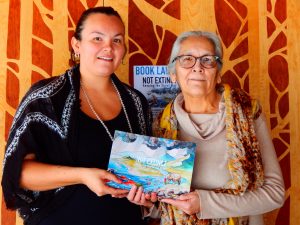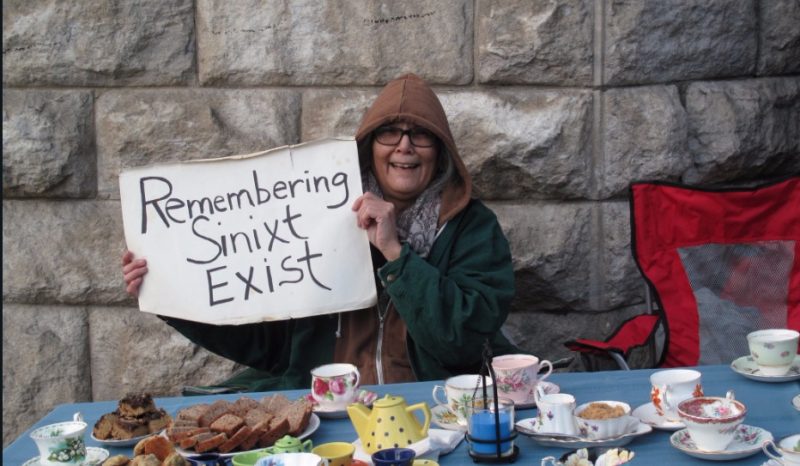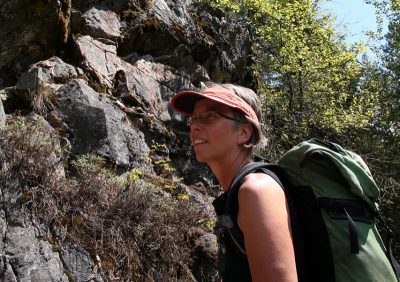Throwing off the cloak of invisibility
The Sinixt of the West Kootenays were declared extinct by the Canadian government in 1956.
November 19th, 2018

Co-authors Taress Alexis and Marilyn James at Vallican Community Centre. Photo by Moe Lyons
To paraphrase Mark Twain, the reports of their extinction were exaggerated, as evidenced by Not Extinct: Keeping the Sinixt Way, by Marilyn James and Taress Alexis of the Sinixt Nation.
Not Extinct: Keeping the Sinixt Way
by Marilyn James and Taress Alexis
Nelson: Maa Press, 2018
$30.00 / 9780968530283
Reviewed by Paula Pryce
*
 Snow drifts, split-rail fences, and patches of open meadow peppered an otherwise heavily treed landscape. There, on a December afternoon years ago, I pondered a collection of tipis on the frosty riverside. The Slocan Valley had always held for me a kind of soothing awe, a place of dense forest, ominous peaks, and swirling, sparkling water, a place where people came to set aside worldly machinations to seek other ways of living. I knew from childhood experience that this quiet, rugged corner of British Columbia attracted artists, Quakers, Doukhobors, and back-to-the-landers. But in those last few days of 1989 when I had returned home from university over the winter break, that land presented something I did not expect. Those tipis belonged to First Nations people who were protesting the exhumation of ancestral remains during road building on the Slocan River at Vallican, a place where Indigenous people and history had until then been invisible to the local settler community.
Snow drifts, split-rail fences, and patches of open meadow peppered an otherwise heavily treed landscape. There, on a December afternoon years ago, I pondered a collection of tipis on the frosty riverside. The Slocan Valley had always held for me a kind of soothing awe, a place of dense forest, ominous peaks, and swirling, sparkling water, a place where people came to set aside worldly machinations to seek other ways of living. I knew from childhood experience that this quiet, rugged corner of British Columbia attracted artists, Quakers, Doukhobors, and back-to-the-landers. But in those last few days of 1989 when I had returned home from university over the winter break, that land presented something I did not expect. Those tipis belonged to First Nations people who were protesting the exhumation of ancestral remains during road building on the Slocan River at Vallican, a place where Indigenous people and history had until then been invisible to the local settler community.
These were Sinixt Interior Salish (or Lakes) people. They had been largely displaced from the West Kootenay region in the late 19th and early 20th centuries due to intensive silver mining and disease. I spent the next decade learning from Sinixt people about their continuing engagement with the land and their love for the ancestors buried therein. I also studied archaeological, ethnographic, and archival records to piece together the history of the Sinixt diaspora. Certainly Sinixt people, whose ancestral territory spans the Canada-US boundary, have been poorly understood. Oral histories and scattered documents tell the story of their lifeways and history in the Columbia, Slocan, and Kootenay Lake valleys, yet no cohesive account had been published. In its ignorance, the Canadian government declared this people extinct in 1956.
Even so, the Sinixt are with us. Because of colonial pressures and a lack of reserve land sanctuaries in Canada, many had moved to the southern reaches of their territory on the Washington State Reservation of the Colville Confederated Tribes, or onto surrounding Canadian reserves. Yet Sinixt people have continually returned to their ancestral territory, eighty percent of which lies in what is now Canada, to hunt, gather, visit family and friends, and attend to sacred sites. My book, ‘Keeping the Lakes’ Way’: Reburial and the Re-creation of a Moral World among an Invisible People (Pryce 1999), was an effort to solve the riddle of this people’s invisibility to settler communities, and to explore the forces that prompted them to keep returning even when Canadian immigration laws attempted to dissuade them.
Not Extinct: Keeping the Sinixt Way throws off the invisibility cloak. A Sinixt mother-and-daughter team, Marilyn James and Taress Alexis have followed in the footsteps of the late Elders Eva Orr and Alvina Lum to work as matrilineal representatives attempting to restore knowledge of their people’s presence in their ancestral territory, to repatriate and rebury exhumed ancestral remains, and to act as environmental stewards of the land. Combining classic Interior Salish oratory and a playful multimedia approach, the book offers stories to teach others about Sinixt laws, culture, language, history, and responsibility to the land.
Not Extinct is a project that conveys generosity and trust. Invisibility and diaspora were a way of survival for Sinixt people during the violence of earlier colonial times. Today, believing that the well-being of their people and their land now depends on being seen and heard, Marilyn James and Taress Alexis have worked with a group of settlers called the Blood of Life Collective to re-introduce their people to non-Sinixt through story.
The Blood of Life Collective. L-R: Marilyn James, Taress Alexis (with children Rocco and Nava), Axel McGown, Amber Santos, Alison Christie, and K.L. Kivi. Photo by Catherine Fisher, who is also part of the collective
The book’s structure shows the collaborative effort: editor K.L. Kivi describes how the collective project was first inspired by fireside conversations and storytelling with Marilyn James. The book retains this oratorial, conversational tone by alternating Sinixt and non-Sinixt voices. Sinixt voices are primary, including online audio recordings and written explanations of classic tales and family histories. Non-Sinixt people contribute responses through visual artwork and written reflections about what they have heard and understood from those stories, their varied perspectives giving a feeling for the diversity of settler cultures. These aural, written, and visual media conversations between Sinixt and non-Sinixt participants comprise the book’s core. It is augmented by introductory remarks, biographical sketches of the collaborators, and glossaries of Sinixt words and phrases and important English terms.
Stories are the heart of the book. Everywhere around the world, oral myths and stories point to life’s deeper meanings. However, the significance of stories relies on an audience’s understanding of specific cultural contexts. They do not always translate easily. Marilyn James and Taress Alexis use symbolic aspects of oratory to explore their culture’s riches, supporting their listeners by explicating Sinixt history and social norms that might not be clear to other peoples. The online audio versions are augmented with book chapters that fill out associated meanings and ideas. So while “How the Sturgeon-Nosed Canoe Came to Be” is itself an engaging story about Sturgeon seducing the bumbling Mrs. Goose and Mrs. Duck to assist in his abduction of Mrs. Fox, the written chapter elaborates implicit aspects, such as the nature of Sinixt waterscapes, river animals, and watercraft technologies, as well as Sinixt views on jealousy, deceit, matrilineal responsibility, and the importance of community.
Similarly, “Coyote and Chickadee,” a complex tale of how Trickster Coyote tried to steal Chickadee’s powerful bow, becomes a springboard to discuss covetousness and the importance of feeling at ease with the variety of personal power (sumíx) one bears, whether it seems impressive or humble to others: “You truly have power when you master your own sumíx, and you’re comfortable in your own skin,” says Marilyn James.
It is worth noting that these tellings show how age and experience can affect oratory. An up-and-coming storyteller, Taress Alexis offers lively readings from the published tales of early-twentieth-century Sinixt author, Mourning Dove (1990), but the compelling oral style of Marilyn James makes clear that she has spent decades at the craft, including at the Kootenay Storytelling Festival. Classic elements of Indigenous oratory that include attention to cadence, tone, alliteration, repetition, and of course humour, tell the audience that they are listening to an experienced storyteller. The written aspects of the book manage to retain that oratory style. Drawing from Lee Maracle’s influential Memory Serves: Oratories (2015), the Blood of Life Collective found ways to bridge the uneasy differences between oral and literary media; by transcribing discussions, the colloquial here-beside-you conversational tone comes through surprisingly well.
Along with old mythic stories, Not Extinct also shares some important personal histories of Sinixt members. In the chapter called “In the Shadow of Extinction,” for example, Marilyn James recounts the youthful experience of Ambrose Adolph who, before the Second World War, drove his Elders in a Model T Ford to their ancestral territory near Revelstoke. In those days as now, many Sinixt people were confined to the Colville Reservation, and despite their efforts at gardening and farming, the land’s resources were so limited that many people were desperately poor. (The Sinixt portion of that reservation had been expropriated by the US government in 1891, and thus their hunting grounds, root fields, and other resources were not protected or easily accessible.)
The story goes that Ambrose and his Elders intended to pan for gold in their ancestral land to help make ends meet. While in that territory, young Ambrose found his way to a stand of old-growth cottonwood trees to hunt for grouse. When he looked up he saw that those towering trees were filled high with racks of caribou antlers. The Elders told him that this was a hunting blind, showing the site to be an ancient Sinixt hunting ground. Ambrose Adolph went away to fight in the Second World War and wanted nothing more than to again visit that powerful place. He survived the war and returned only to find that the trees had disappeared. Marilyn James’s voice in the audio recording abruptly concludes, “All that was left were fences and fields.” This sobering story then leads on to a detailed written discussion on how population growth, the loss of old-growth trees, and the obstruction of migratory corridors by roads and land clearing have contributed to the critically endangered status of the Selkirk Mountain Caribou, which had once been plenteous in the region.
These stories and others illustrate the major themes of the book: relationships, commitments, responsibility, and service, especially regarding land and ancestors. The reflections, both Sinixt and non-Sinixt, convey a deep longing to make things right and to follow a path of reconciliation that seeks justice and the creation of community. The book is an outcome of that communal desire. Indeed, the thoughtful collaborative process that Marilyn James, Taress Alexis, and non-Sinixt participants devised to create the book could be taken as a model by other Canadians who seek ways towards reconciliation between First Nations and settler communities. Not Extinct: Keeping the Sinixt Way models both hope and action.
Maracle, Lee. 2015. Memory Serves: Oratories. Edmonton: NeWest Press.
Mourning Dove. 1990. Coyote Stories. Lincoln: University of Nebraska Press.
Pryce, Paula. 1999. “Keeping the Lakes’ Way”: Reburial and the Re-creation of a Moral World Among an Invisible People. Toronto: University of Toronto Press.
*
Paula Pryce is a lecturer and research associate in the Anthropology Department at the University of British Columbia. She is the author of “Keeping the Lakes’ Way:” Reburial and the Re-creation of a Moral World Among an Invisible People (University of Toronto Press, 1999), and The Monk’s Cell: Ritual and Knowledge in American Contemplative Christianity (Oxford University Press, 2018).
*
The Ormsby Review. More Books. More Reviews. More Often.
Editor/Designer/Writer: Richard Mackie
Publisher/Writer: Alan Twigg
The Ormsby Review is a journal service for serious coverage of B.C. books and authors, hosted by Simon Fraser University. The Advisory Board consists of Jean Barman, Robin Fisher, Cole Harris, Wade Davis, Hugh Johnston, Patricia Roy, David Stouck, and Graeme Wynn. Scholarly Patron: SFU Graduate Liberal Studies. Honorary Patron: Yosef Wosk. As of September, 2018, Provincial Government Patron: Creative BC
“Only connect.” – E.M. Forster
K.L. Kivi edited Not Extinct: Keeping the Sinixt Way. Kivi is author and editor of eight books of fiction and non-fiction, including The Town of Nothing, The Purcell Suite, and her first, Canadian Women Making Music (1992). Photo by Karen Warkentin











Leave a Reply